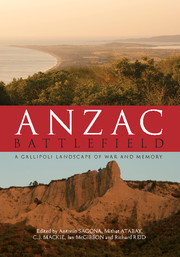Book contents
- Frontmatter
- Foreword
- Contents
- Figures
- Plates
- Contributors
- Acknowledgements
- Abbreviations
- Gallipoli battlefield place names
- Introduction
- 1 Boundary and divide: The antiquity of the Dardanelles
- 2 The Gallipoli campaign: History and legend
- 3 Recording the battlefield: First steps
- 4 Capturing the battlefield: Mapping and air photography at Gallipoli
- 5 Battlefield archaeology: Gallipoli
- 6 Forming the ANZAC battlefield
- 7 Forming the Ottoman battlefield
- 8 Artefacts from the battlefield
- 9 Remembering Gallipoli
- 10 Remembering Gallipoli from a Turkish perspective
- Conclusion
- Appendix Anzac Gallipoli Archaeological Database
- References
- Index
5 - Battlefield archaeology: Gallipoli
Published online by Cambridge University Press: 05 December 2015
- Frontmatter
- Foreword
- Contents
- Figures
- Plates
- Contributors
- Acknowledgements
- Abbreviations
- Gallipoli battlefield place names
- Introduction
- 1 Boundary and divide: The antiquity of the Dardanelles
- 2 The Gallipoli campaign: History and legend
- 3 Recording the battlefield: First steps
- 4 Capturing the battlefield: Mapping and air photography at Gallipoli
- 5 Battlefield archaeology: Gallipoli
- 6 Forming the ANZAC battlefield
- 7 Forming the Ottoman battlefield
- 8 Artefacts from the battlefield
- 9 Remembering Gallipoli
- 10 Remembering Gallipoli from a Turkish perspective
- Conclusion
- Appendix Anzac Gallipoli Archaeological Database
- References
- Index
Summary
Whether set in remote antiquity or the modern world, battles and battlefields are generally perceived as the purview of military historians. Although broad themes such as the causes of war form a crucial element of military history, specific campaigns have often been investigated from the perspectives of strategy, logistics, tactics and manoeuvres of opposing armies. These mechanical and operational categories continue to attract attention, to be sure, but over the last quarter century or so the study of armed conflict has seen a significant shift of emphasis. Interdisciplinary approaches to an anthropological archaeology of modern conflict have developed, in which the study of human nature under the duress of battle – why soldiers behave the way they do and how their behaviour relates to their physical environment – is now considered of prime importance. Archaeological approaches and analyses have found an important role to play in these investigations, through the archaeologists’ attention to the physical record of human activity. Research concentrates on identifying the material remains of battlefields in which people not only fought and died but also lived for days, weeks or months at a time, building kitchens, sleeping quarters, medical posts, supply depots and all those related features that make up the landscape of warfare behind the front lines. Using material culture to understand the way people behaved during battles is the contribution archaeology makes to the study of battlefields and conflict more generally.
This emphasis on the materiality of war, especially modern technological conflict like the First World War, is a relatively new advance. Accordingly, objects of war are not necessarily viewed as functional items but as possessing their own ‘social lives’, whose biographies have yet to be written fully. Likewise the contested and tragic landscapes of destruction are multilayered places of commemoration and pilgrimage, as well as tourist attractions and sites that require heritage management. This broad anthropological approach, sometimes called ‘agency theory’, owing to the explicit emphasis it places on the human agent, has emerged as a powerful tool in the rapidly expanding discipline of battlefield archaeology, or, to use the more inclusive term, conflict archaeology. The underlying principle is that each military site, whether the scene of a protracted campaign or a brief encounter, has a distinct ‘fingerprint’, which was formed by the pressures of war, changing technology and the cultural backgrounds of the combatants.
- Type
- Chapter
- Information
- Anzac BattlefieldA Gallipoli Landscape of War and Memory, pp. 83 - 97Publisher: Cambridge University PressPrint publication year: 2016
- 1
- Cited by



